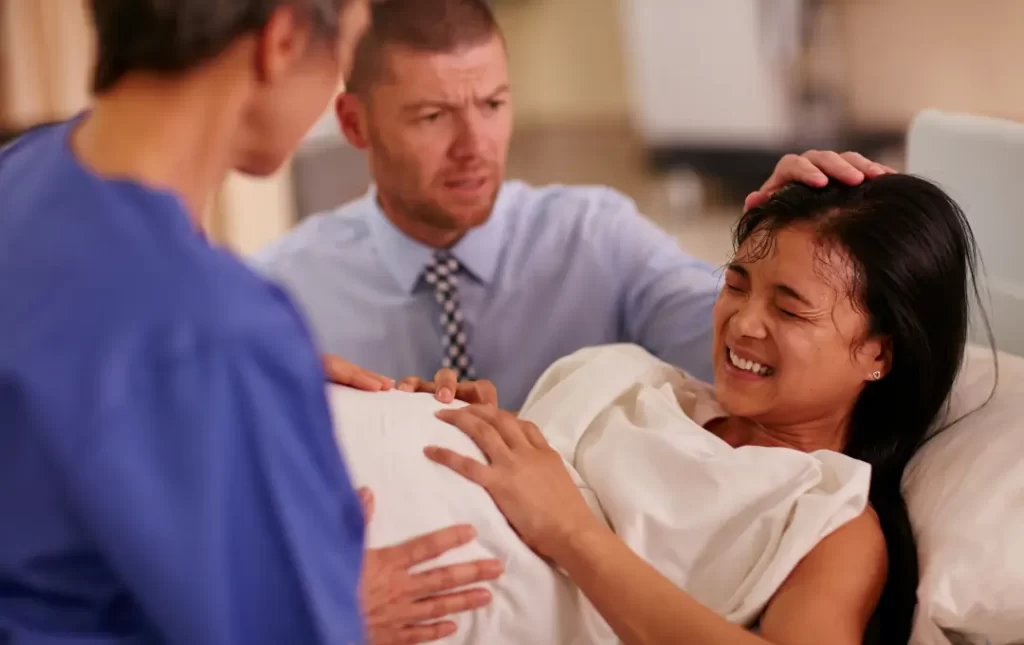Birth Injury Lawsuit
Birth injuries can be a traumatic experience for any family. When a newborn baby suffers from injuries during the birthing process, it can lead to long-term health issues. Sometimes these injuries are preventable and caused by medical negligence. This guide explains what a birth injury is, how it happens, and what you can do if your child has been affected.

Written by: Nicky from Legal Claim Assistant, Last updated: March 27, 2024

NEC Baby Formula
NEC baby formula lawsuits guide for families seeking compensation and justice for you.
Table of Contents
What is a Birth Injury?
A birth injury refers to any harm that a baby suffers during the birth process. These injuries range from minor bruises to severe trauma, such as spinal cord injuries or brain damage.
Birth injuries, also known as birth trauma, occur when a newborn baby sustains physical damage before, during, or just after the birthing process. The severity of these injuries can range from minor, temporary conditions to more severe, long-term disabilities.

Understanding Common Birth Injuries
Most birth injuries are the result of physical pressure or trauma during the birthing process. For instance, the baby’s head might be injured while passing through the birth canal, potentially leading to cranial nerve injuries or minor injuries like subcutaneous fat necrosis. In some cases, the baby’s shoulder may become lodged against the mother’s pelvic bone, a condition known as shoulder dystocia, which can cause brachial plexus injuries. This group of nerves, running from the spinal cord through the upper arm bone, controls movement and sensation in the arm. If damaged, it may lead to brachial plexus palsy, necessitating therapies such as physical therapy or occupational therapy.
Spinal cord injuries in newborn babies, though rarer, can have significant implications, potentially resulting from traumatic births where the spine or surrounding blood vessels are affected. These types of injuries, alongside brain injury, cerebral palsy, and intracranial hemorrhage, are among the most severe birth injuries and require an experienced medical team for diagnosis and treatment.
Risk Factors and Prevention
A variety of risk factors can increase the likelihood of a birth injury. These include maternal obesity, complications with the unborn child’s position, such as breech delivery, and certain medical conditions in both the mother and child. Family medical history and conditions like gestational diabetes also play a role. Medical professionals monitor for these risk factors to anticipate and prevent birth trauma.
Understanding the possible risk factors and signs of distress during labor can prompt quick actions by the birthing team, potentially mitigating the severity of injuries. In some severe cases, such as with brachial plexus nerve damage or spinal cord injury, long-term care and therapy may be necessary to manage the child’s birth injury and improve their prognosis.
Birth injury prognosis varies, with many children recovering fully over a few weeks or months, while others may face lifelong challenges. Diagnosis typically involves careful examination by healthcare providers, often at institutions like Stanford Children’s Health, where advanced techniques help determine the precise nature and extent of the injury. In cases where birth injuries result from medical negligence in childbirth or delivery room errors, families may seek newborn injury compensation through obstetric malpractice claims.
Need help filing a Birth Injury Claim?
Common Types of Birth Injuries
Birth injuries can range from mild to severe and may affect different parts of a newborn baby’s body. Understanding these injuries is crucial for early diagnosis and treatment. Here are ten common types of birth injuries, which encompass a variety of physical traumas a newborn might encounter during the birthing process:
Brachial Plexus Injuries: These occur when the bundle of nerves around the baby’s shoulder is damaged, often leading to conditions like brachial plexus palsy.
Cerebral Palsy: A result of brain injury or malformation during birth, affecting muscle tone and movement.
Spinal Cord Injuries: These severe injuries can happen if there is trauma to the spinal cord during delivery.
Intracranial Hemorrhage: This term refers to bleeding under the cranium, which can happen due to birth trauma.
Facial Nerve Injuries: If the facial nerve is damaged, it can lead to facial nerve palsy, affecting facial movements.
Skull Fractures: These can occur during traumatic births, especially if instruments like forceps are used improperly.
Perinatal Asphyxia: A condition where the baby does not receive enough oxygen before, during, or just after birth, leading to hypoxic-ischemic encephalopathy (HIE).
Erb’s Palsy: A form of brachial plexus injury where the upper arm’s nerves are damaged, often related to shoulder dystocia during birth.
Subcutaneous Fat Necrosis: A less common condition involving inflammation of fat tissue under the skin, possibly resulting from birth trauma.
Broken Bones: Clavicle fractures are the most common broken bone injury during birth, often occurring when there’s difficulty delivering the baby’s shoulder.
Each of these injuries requires a careful birth injury diagnosis to manage and treat effectively. Treatment can range from occupational therapy for mild nerve injuries to more intensive medical interventions for conditions like cerebral palsy and severe cases of spinal cord damage. As newborn babies are particularly vulnerable, an experienced medical team’s swift response is crucial to address these injuries and support the child’s life and well-being.

Causes of Birth Trauma
Birth trauma can stem from complications in the birth canal, leading to conditions like brachial plexus injuries or cerebral palsy. Factors such as prolonged labor, maternal healthcare negligence, or improper fetal monitoring can cause these injuries. Recognizing these risks is essential for preventing neonatal birth trauma and safeguarding an unborn child’s health.
Understanding Brachial Plexus Birth Injuries
Brachial plexus birth injuries, often stemming from neonatal birth trauma, occur when the network of nerves near the baby’s shoulder is damaged during delivery. These injuries can lead to weakness or loss of movement in the arm, impacting the child’s physical development. Accurate birth injury diagnosis is critical for effective treatment.
Risk Factors for Birth Injuries
1. Maternal Health and History: Existing conditions like maternal diabetes, obesity, and a history of birthing complications can elevate the risk of birth injuries such as brachial plexus injury or cerebral palsy.
2. Birthing Process Complications: Difficulties in the birth canal, especially if the baby’s shoulder becomes lodged (shoulder dystocia), can lead to brachial plexus injuries and other trauma.
3. Delivery Methods: The use of instruments like forceps or vacuum extractors can increase the risk of skull fractures, cerebral palsy, and other neonatal birth traumas if not used correctly.
Diagnosing a Birth Injury
Early diagnosis is crucial for managing birth injuries. We’ll discuss signs to look for and how medical professionals diagnose conditions like brachial plexus birth palsy.
Legal Rights and Birth Injuries
When a child suffers birth injuries, such as brachial plexus injuries or spinal cord damage, due to medical negligence, the family has legal rights that can be exercised through a birth injury lawsuit. The process typically involves several steps, starting with a thorough investigation of the birthing process and medical care provided.
Firstly, an evaluation of the newborn baby’s injuries is conducted, often involving experts in neonatal care. If injuries like brachial plexus birth injury or intracranial hemorrhage are linked to potential medical errors, such as improper handling of birth defects or maternal risk factors, legal action may be warranted. In cases where forceps delivery or vacuum extraction complications have occurred, this can strengthen the claim of negligence.
Parents should consult a pediatric injury attorney specializing in cases like brachial plexus injuries or traumatic birth scenarios. An attorney will review medical records, including any fetal distress legal action taken during labor or neonatal resuscitation litigation post-birth. They’ll assess incidents like cervical nerve root damage or facial nerve palsy to establish a link between the medical team’s actions and the injuries sustained.
The legal claim may allege that the medical team failed in preventing avoidable conditions such as obstetrical brachial plexus palsy or failed to properly address maternal healthcare rights. A successful claim may cover physical therapy costs, address long-term care standards for injuries, and compensate for the emotional distress caused by the birth trauma.
In severe cases, such as when an unborn child suffers from anoxic or hypoxic injury cases due to neonatal intensive care errors or obstetrical triage mistakes, the legal action can become a significant pursuit of justice. Legal representation can ensure that the family’s rights are upheld and that any instances of maternity healthcare negligence are addressed, offering a semblance of relief and support for the child’s future.

The Role of a Birth Injury Lawyer
A birth injury lawyer plays a pivotal role in representing families whose newborns have suffered birth traumas such as brachial plexus injuries, cerebral palsy, or spinal cord damage. Specialized in the intricate landscape of medical malpractice law, these attorneys scrutinize the birthing process to uncover any breaches in the standard of care.
They understand the complexities of cases involving birth defects, neonatal care lawsuits, and injuries caused by labor and delivery care standards not being met. These legal professionals navigate through medical records, highlight instances of prenatal misdiagnosis, and identify any delivery room errors, such as those related to forceps or vacuum extractions.
By building a case around the medical errors that led to physical injuries and presenting evidence of the physical symptoms suffered by the newborn, a birth injury lawyer seeks compensation for the medical oversight. This not only addresses the immediate medical expenses and physical therapy required but also secures funds for any long-term care needs resulting from permanent disabilities.
Find out how much your payout could be:
Financial Compensation for Birth Injuries
When a newborn suffers birth injuries, such as brachial plexus injuries or cerebral palsy due to medical negligence, the family may be entitled to financial compensation. This restitution aims to cover a wide range of costs related to the injury, including but not limited to ongoing medical treatment, physical therapy for spinal cord injuries, and specialized care for conditions like erb’s palsy.
Understanding Your Compensation Rights
Financial awards can also provide for the future needs of the child, including adaptations for living with long-term disabilities that may arise from severe birth trauma. Compensation may cover losses beyond the immediate medical bills, such as the baby’s lifelong loss of earning potential, especially in cases where the newborn baby suffers from brain tissue damage or other severe conditions like hypoxic-ischemic encephalopathy (HIE).
To navigate these complex claims, families often seek legal action through neonatal care lawsuits, which address errors in the delivery room, from forceps delivery legal issues to medication errors during labor. The goal is not only to address the physical symptoms and suffering of the child but also to ensure the family’s financial stability and the child’s quality of life are safeguarded.

Find out how much your birth injury lawsuit payout could be:
Birth Injury Lawsuit Process
Talk to a Lawyer: Start by talking to a lawyer who knows about birth injuries. Legal Claim Assistant can help you find the right one for free.
Review Medical Records: Your lawyer checks all medical records to find proof of what went wrong.
Get Expert Advice: Sometimes, you need a doctor’s opinion to show the court that something was not done right. Your lawyer will handle this.
File the Lawsuit: Your lawyer will officially start the lawsuit to ask for money to cover the harm done.
Share Information: Both sides exchange information. Your lawyer will take care of the complicated parts.
Try to Settle: Before going to court, your lawyer will try to agree on compensation with the other side.
Go to Court if Needed: If no agreement is reached, your lawyer will argue your case in court.
Get Compensation: If you win, the next step is to collect the money awarded.
Legal Claim Assistant makes finding the right attorney easy. They connect you with experienced lawyers who specialize in birth injuries, ensuring you have expert support every step of the way.

Your Legal Case Matters to Us
At Legal Claim Assistant, we understand the impact that defective medical devices can have on your life. From escalating medical bills to the stress of dealing with health problems and device malfunctions, the challenges are immense. Whether it’s a design defect in a prosthetic device, complications from medical technology hazards, or issues arising from medical device recalls, we are here to help.
Our expertise in medical device cases, coupled with our commitment to regulatory compliance and patient safety, positions us to provide you with the legal recourse you deserve. We strive to ensure that every client receives personalized attention, from handling your medical device complaint to navigating the pre-market approval process and tackling post-surgical device complications.
If you’re grappling with injuries or health complications due to a defective device, reach out to us. We are committed to helping you find the legal recourse for medical injuries you deserve, focusing on securing compensation and advocating for defective device corrective actions on your behalf. Let us guide you to the right legal team, making your case a priority and seeking justice for the challenges you’ve faced.
Need help with an Birth Injury Claim?
FAQs on Birth Injuries
1. What is a birth injury?
A birth injury is harm that a baby suffers during the birthing process. This can range from minor bruises to more severe injuries like brachial plexus injuries, cerebral palsy, or spinal cord damage.
2. What causes birth injuries?
Birth injuries can result from various factors, including complications during labor and delivery, the size and position of the baby, or medical negligence. For example, using forceps or vacuum extractors improperly can lead to injuries.
3. How do I know if my baby has a birth injury?
Signs of a birth injury can vary widely but may include physical signs like bruising or swelling, difficulty feeding, seizures, or a lack of muscle control. If you notice any concerning symptoms, consult a healthcare provider for a thorough examination.
4. Can birth injuries be treated?
Yes, many birth injuries can be treated with early intervention. Treatment options depend on the type and severity of the injury and may include physical therapy, surgery, medication, or specialized care.
5. What legal options do I have if my baby suffered a birth injury?
If your baby’s birth injury was due to medical negligence, you might have grounds for a lawsuit. A birth injury lawyer can help you understand your rights and guide you through the legal process to seek compensation for medical bills, ongoing care costs, and other damages.
Birth Injury Statistics and Facts
In the U.S., around 6 to 8 in every 1,000 newborns experience a birth injury, with brachial plexus injuries and fractures being among the most common. Factors like delivery room errors and complications during the birthing process contribute to these incidents. Despite advances in birth injury prevention and treatment, including addressing hypoxic-ischemic encephalopathy (HIE) and erb’s palsy, these injuries continue to affect thousands of babies, highlighting the importance of neonatal care and legal options for affected families.
How to Support a Child with a Birth Injury
For families navigating the aftermath of a birth injury, understanding how to provide optimal support is crucial. This encompasses physical care, emotional support, and adapting to educational needs. Addressing birth injuries like brachial plexus or spinal cord injuries early through treatments and therapies can significantly improve outcomes. Equally important is recognizing and validating the emotional toll on the family, offering a foundation for resilience and coping strategies.

Preparing for a Birth Injury Lawsuit
Embarking on a legal battle requires careful preparation, starting with a comprehensive collection of medical records, expert testimonies, and a detailed account of the birth process. A legal team experienced in birth injuries will navigate the complexities of the lawsuit, from initial filings to potential courtroom proceedings.
Navigating the Complex World of Birth Injuries: Understanding, Prevention, and Legal Action
Birth injuries, an umbrella term for injuries newborns might suffer before, during, or shortly after birth, can range from minor bruises to severe conditions like spinal cord injuries and brachial plexus injuries. These injuries, sometimes referred to as birth trauma, are not only physically daunting but also bring a heavy emotional toll on families. Understanding the causes, risk factors, and avenues for treatment and legal recourse is crucial for affected families.
Understanding Birth Injuries
Birth Trauma Explained: The trauma experienced during the birthing process can lead to various injuries, including the often-discussed brachial plexus birth injury. This particular injury occurs when the bundle of nerves responsible for arm movement, known as the brachial plexus, is damaged, potentially during a difficult delivery when the baby’s shoulder is lodged against the mother’s pelvic bone.
The Spectrum of Birth Injuries: From the pressure exerted on the baby’s head navigating the birth canal, potentially leading to cranial nerve injuries, to traumatic birth incidents resulting in spinal cord damage, the spectrum of birth injuries is broad. Conditions like cerebral palsy and intracranial hemorrhage also fall within this spectrum, necessitating an experienced medical team for diagnosis and treatment.
Risk Factors and Prevention
Identifying Risk Factors: Several factors can elevate the risk of birth injuries. Maternal risk factors such as obesity, complications with the baby’s position, like breech deliveries, and even the family medical history can influence the likelihood of birth trauma. Additionally, obstetrical brachial plexus palsy and conditions like subcutaneous fat necrosis underscore the complexity and unpredictability of birth injuries.
Prevention Strategies: Understanding and mitigating risk factors is key to preventing birth injuries. This includes addressing maternal health concerns, proper monitoring of the baby’s position, and preparing for a safe birthing process. In situations where risks are identified, such as potential for shoulder dystocia, having a plan and an experienced medical team ready can make a significant difference.

Diagnosis, Treatment, and Prognosis
Early Diagnosis: Stanford Children’s Health and similar institutions emphasize the importance of early diagnosis in managing birth injuries. Conditions like brachial plexus birth palsy require prompt attention for the best possible outcome.
Comprehensive Treatment: Treatment varies widely, from physical therapy for minor injuries to more intensive interventions for severe cases like spinal cord injury. Occupational therapy also plays a crucial role in rehabilitation, helping children overcome the challenges posed by their injuries.
Looking Forward: The prognosis for birth injuries can vary, with many children seeing significant improvement over time. However, for some, like those affected by severe brain injury or cerebral palsy, long-term care may be necessary.
Legal Rights and Support
Don’t wait any longer to seek the justice and compensation that’s rightfully yours. Legal Claim Assistant is here to help you every step of the way. Reach out to us now for a comprehensive, free evaluation of your birth injury case. You’ll have the chance to discuss your situation with a knowledgeable assistant who is dedicated to understanding your needs and guiding you through your options. We’re committed to connecting you with the right legal support to address your specific circumstances.
By choosing to act today, you’re not just taking the first step towards recovery; you’re also moving closer to the compensation you and your family deserve for the hardships you’ve endured due to a birth injury. Let Legal Claim Assistant be your partner in navigating this journey, offering the support, expertise, and care you need to start healing and reclaiming your life.
Need help with an Birth Injury Claim?

Navigating Birth Injury Lawsuits: Understanding Your Rights
When a joyous occasion like childbirth results in unexpected complications or injuries due to medical negligence, families may find themselves considering a birth injury lawsuit. Such legal actions are crucial when medical professionals fail to provide the standard of care required, leading to preventable birth injuries ranging from cerebral palsy to spinal cord injuries. An experienced birth injury attorney can guide you through the legal process, leveraging medical experts to prove medical malpractice and secure rightful compensation. Birth injury claims not only cover medical expenses but also ensure the future care needs of the child are met. With the support of a specialized legal team, parents can navigate birth injury law firms to achieve a birth injury settlement that reflects the profound impact of medical mistakes on their child’s life.
The Role of Medical Malpractice in Birth Injuries
Medical malpractice plays a significant role in most birth injury lawsuits, where the negligence of medical providers during childbirth causes harm such as brain damage or fetal distress. Birth injury malpractice cases hinge on demonstrating how medical malpractice attorneys, through detailed analysis and expert testimony, can establish a direct link between the medical professional’s actions and the child’s injuries. Whether it’s a wrongful death lawsuit or a claim for cerebral palsy caused by birth trauma, the objective remains the same: to hold negligent health care providers accountable. Birth injury lawsuit settlements often reflect the severity of the injury and the lifelong impact on the child and their family, emphasizing the importance of securing the best birth injury lawyers for a comprehensive birth injury claim.
Get help now
Written by:
Nicky from LegalClaimAssistant.com
LegalClaimAssistant.com simplifies the process of pursuing legal action. Access information, lawsuit guides, and updates on drugs, products, and other matters that may impact you.
4 References
- Holpuch, Amanda. “Two Army Veterans Awarded $110 Million in 3M Earplug Lawsuit.” The New York Times. January 28, 2022. Retrieved on May 12, 2022 from https://www.nytimes.com/2022/01/28/us/veterans-earplugs- 3m-lawsuit.html
- LexisNexis® Legal Insights. “Product liability & strict liability.” January 06, 2021. Retrieved on May 5, 2022 from https://www.lexisnexis.com/community/insights/legal/b/thought-leadership/posts/understanding-the- interplay-between-strict-liability-and-products-liability
- National Highway Traffic Safety Administration. “Letter to Tesla: Full Self-Driving Software May Cause Crash.” Retrieved from: https://static.nhtsa.gov/odi/rcl/2023/RCAK-23V085-2525.pdf. Accessed on February 17, 2023.
- Unified Parkinson’s Advocacy Council. “Paraquat Dichloride Registration Review.” July 24, 2017. Retrieved on May 12, 2022 from https://files.michaeljfox.org/Paraquat_letter_FINAL.pdf



